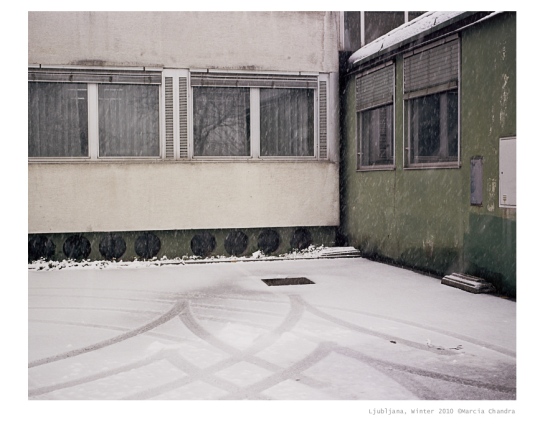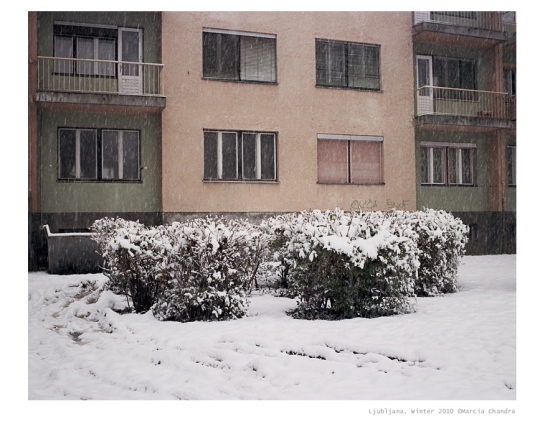As I’m currently not writing as much, this blog is on hiatus for time undetermined.
You can follow me over on Tumblr where I share images and notes on my travels and work.
thanks for following. xx
As I’m currently not writing as much, this blog is on hiatus for time undetermined.
You can follow me over on Tumblr where I share images and notes on my travels and work.
thanks for following. xx


Developed some film I found a few weeks ago. Some lost treasures and memories. These were taken in Ljubljana in November 2010. I really love the urban landscape there, especially under snow.
Well, its been 2 years since I last blogged, and my last post was about, uh, weddings… So, lots to catch up on. I’ve been working on lots of commissions over the past 2 years for some editorial and commercial clients. I’ve traveled to Mali, Canada, Bangladesh, India and Thailand. I also spent the greater part of the past year on various editing/research projects for the Telegraph magazines, the Majority World Photo Agency, and the International Development Research Centre. And I curated an exhibition at The Guardian Gallery in July—“Insider, Outsider? Photography that challenges perceptions of the developing world”—featuring 17 of Majority World’s talented photographers from Africa, Asia, Latin America and the Middle East.
So, its been busy, but Im really looking forward to finally having more time to focus on my photography. I’m currently going through all the work I’ve done over the past 2 years as I prepare to (re)launch, and I’ll be using this space as I edit to share the pieces I’ve picked up along the way…
…such as these images taken at the Tottiford Reservoir in the Dartmoors, reflecting my enchantment with Devon and all things Cornwall.

I have a few friends that consider themselves documentary or commercial photographers, and also do a lot of weddings “on the side.” Depending on who the client is (and how much insistence there is on super cheeze), some of their documentary-style wedding work can often be quite subtle and beautiful. Yet, try and find their work online… no one likes to admit that they do them. Well, unless they are shot in another country or a minority culture, at which point they might be referred to as “ethnographic studies in culture” (yes, that is tongue in cheek).
I read an interesting post on A Photo Editor the other day about wedding work. Key notes: do it, there could be value in admitting it, but find ways to market it separately from you other work while incorporating relevant elements in your editorial/commercial portfolio.
By now I have shot a few weddings myself and, to be honest, the experiences have given me a lot that I can take into my documentary work: making quick decisions about lighting, location, lenses; dealing with clients and what they want while staying true to your own style; standing on your feet for 8 hours shooting; making sure you get all the key shots that they want to see (that ring exchange or cake in the face is only going to happen once); and making something unique and personal out of potential cheeze… There is some work I’ve shot that I really like and hope that similar conditions come up in my documentary photography…
– london, uk, 21 degrees this fine cloudy evening (!), listening to “Lola” by the Kinks
A few weeks ago I went to the 2nd installment of the Carousel Slide Slam hosted by Jon Levy at the Host Gallery. I wasn’t sure what to expect as I’d heard mixed reviews about the first one, but I quite liked it. While the order could have been a little better (difficult to follow a comedy routine with a heavy slideshow on human rights), I really liked the experimental nature of many of the slideshows and the different formats. One of my faves of the evening was a hilarious talk on pinhole photography by Justin Quinnell–makes me want to go do one of his workshops.
Another fave was work shown by Pablo Hare on Peruvian monuments in small town public squares where they have created their own heroes.
Rather than have a Q&A with each of the presenters, there were several breaks during the evening presumably so people could chat about the work shown, or photography, or their amusement over the election results. It would have been nice to have some more room for formal dialogue especially around some projects that were more experimental; for example, I would have wanted to talk a little about the work shown by Kim Thue, or rather, for him to talk a little bit more about it. The black and white images he showed of people in Freetown were mixed with an experimental layered audio, which I also found quite an interesting approach (you can see it on the Zimmer/117 site). The images were extremely beautiful, however, the work showed anonymous and suffering (Freetown) Africans with violent marks of physical pain and apparent disenchantment with their lives. There was no context as to how they received these marks, who they were or the project’s relevance, and it felt too much like the traditional and insensitive (white/western) portrayal of Africa; I left feeling like I knew less than I did before. Perhaps it was not trying to make a statement, perhaps it was an art project combining dramatic image and sound? And, if so, why in Freetown, why these people? As much as I love the photography and the innovative use of sound, I really dont like seeing work like this that lacks context.
[Two interesting articles worth mentioning here: How to Write about Africa, by Binyavanga Wainaina published in Granta 92, Winter 2005; and How To Take Photos Of Africa Or Where Intent And Ideas Collide by Asim Rafiqui on the Spinning Head Blog, March 2010.]
But I digress. It was a nice, diverse event and I hope that there will be more room for dialogue on some of these interesting approaches to storytelling in future slideslams, speaking of which, next one is on June 14.
– london, uk, cool 11 degree evening, listening to “Water No Get Enemy” by Fela Kuti
Over the past few weeks I have been fairly busy working, designing and editing my website (about to be launched!) and collaborating on some interesting projects that I keep meaning to share here… um, a little late, but here’s one update.
For a few weeks I was working with the Think Act Vote campaign photographing for the campaign’s book. Think Act Vote was using fashion as a way to engage younger audiences to vote in the election. What I liked about it was how it tried to get people to think about the election as more than just a one-off event but how political choices impact us on a daily basis. Amisha Ghadiali, a jeweller and Associate Director of the Ethical Fashion Forum launched the campaign by getting local fashion designers to ‘remake’ the campaign tshirt into one-off pieces. The other part of the campaign has been getting people to fill in their own answers to “The future I choose…” and setting up photobooths in various locations where everyone gets to have a professional shoot wearing the campaign t-shirt. The results will be published in a book to be presented to the Prime Minister later this year.
Ill share some images from the portrait shoots later but here are some images from the pre-election party at Camp London. Also, there is still time to fill in your own answer to “The future I choose…” and be included in the book–fill the form out online.
– london, uk, about 19 degrees on a bright sunny afternoon, listening to “Feeling Good” by Nina Simone

Im heading down to Bristol for the weekend to catch some shows at the Bristol Festival of Photography and go to the life.still exhibition where my friend Rebecca Harley is showing some of her work combining beautiful portraits and personal stories. The opening night (tonight!) is also featuring an ‘open democratic slideshow’ of submissions from all over the world, including my work in African immigrants in Almeria—Permanently Temporary.
Join the party tonight! 7-10pm, 62 Queens Road, Bristol
I’m preparing to go to Manchester for a photo shoot and staring at my “to do” wall. This picture is from a few days ago and lots of things have moved around and been added since then; so, a fairly productive week. Must add a few more stickies: “put pictures on walls” and “throw out dead flowers”.
– london, uk, 20 degrees (really?) cloudy afternoon, listening to my neighbour’s kid play (horrible) piano